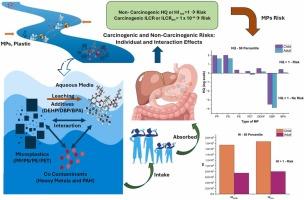Synergistic human health risks of microplastics and co-contaminants: A quantitative risk assessment in water
IF 11.3
1区 环境科学与生态学
Q1 ENGINEERING, ENVIRONMENTAL
引用次数: 0
Abstract
The pervasive presence of microplastics (MPs) in aquatic environments, coupled with their potential to act as vectors for toxic contaminants, raises significant concerns for human health. This study quantifies the health risks associated with the ingestion of microplastics and their co-contaminants in aquatic medium, considering both individual and interactive effects. The analysis encompasses four MP types (PP, PS, PET, PE) and prevalent contaminants including heavy metals (Cr, Cu, Ni, Pb), polycyclic aromatic hydrocarbons (PAHs, expressed as BaP equivalents), and plastic additives (DEHP, DBP, BPA)—to calculate individual Hazard Quotient (HQ), interaction-based Hazard Index (HIint), individual Incremental Lifetime Cancer Risk (ILCR), and interaction-based ILCR (ILCRint). The mean concentration of MPs in aqueous media was determined to be 2.19 mg/L (95 % CI), and Chronic Daily Intake (CDI) values were derived from particle counts converted to mass using polymer-specific densities. Reference Dose (RfD) values were calculated using the Weight of Evidence (WoE) approach, which integrates findings from rodent toxicity studies, identifying PP and PS as having low RfD values 25 × 10⁻⁴ mg/kg bw/day and 8 × 10⁻⁴ mg/kg bw/day, respectively. HQ-based toxicity rankings indicated the order of risk as PP > PS > PE > PET. Findings revealed a pronounced HIint of 18.646 × 10³ and 16.649 × 10⁶ at the 50th and 90th percentiles in children, underscoring significant synergistic effects from combined exposure to MPs and leached plastic additives. Co-contaminant scenarios further escalated health risks, with HI values reaching 52.236 in the presence of heavy metals and 53.141 with PAHs. The maximum allowable MP concentration, considering additive leaching, was estimated at 0.011 mg/L. This research highlights the need for firstly understanding the transformations of microplastic in the aquatic medium along with co-contaminants and framing regulatory measures and improved monitoring to protect human health from the growing threat of microplastic pollution. By integrating exposure modeling, dose-response assessment, and Monte Carlo simulations, the study delivers a robust framework for environmental health guidelines. It emphasizes the complex, multifaceted risks MPs pose and their associated contaminants, calling for innovative solutions to safeguard public health against this pervasive environmental challenge.

微塑料和共污染物对人类健康的协同风险:水中的定量风险评估
微塑料在水生环境中的普遍存在,再加上它们可能成为有毒污染物的载体,引起了对人类健康的重大关切。考虑到个体和相互作用的影响,本研究量化了与在水生介质中摄入微塑料及其共污染物相关的健康风险。该分析包括四种MP类型(PP, PS, PET, PE)和常见污染物,包括重金属(Cr, Cu, Ni, Pb),多环芳烃(PAHs,以BaP当量表示)和塑料添加剂(DEHP, DBP, BPA),以计算个体危害商(HQ),基于相互作用的危害指数(HIint),个体增量终身癌症风险(ILCR)和基于相互作用的ILCR (ILCRint)。水介质中MPs的平均浓度确定为2.19 mg/L (95% CI),慢性每日摄入量(CDI)值由使用聚合物特异性密度转换为质量的颗粒计数得出。参考剂量(RfD)值是使用证据权重(WoE)方法计算的,该方法综合了啮齿动物毒性研究的结果,确定PP和PS的RfD值较低,分别为25 × 10⁻⁴mg/kg体重/天和8 × 10⁻⁴mg/kg体重/天。基于hq的毒性排名显示,风险顺序为PP >;PS祝辞体育比;宠物。研究结果显示,儿童在第50和第90百分位数的HIint值分别为18.646 × 10³和16.649 × 10 26,这表明多聚物和浸出塑料添加剂的联合暴露具有显著的协同效应。共污染情景进一步加剧了健康风险,重金属存在时的HI值为52.236,多环芳烃存在时的HI值为53.141。考虑添加剂浸出的最大允许MP浓度估计为0.011 mg/L。这项研究强调,首先需要了解微塑料在水生介质中的转化以及共同污染物,并制定监管措施和改进监测,以保护人类健康免受微塑料污染日益严重的威胁。通过整合暴露建模、剂量反应评估和蒙特卡罗模拟,该研究为环境健康指南提供了一个强大的框架。报告强调了国会议员带来的复杂、多方面的风险及其相关污染物,呼吁采取创新解决方案,保护公众健康,应对这一普遍存在的环境挑战。
本文章由计算机程序翻译,如有差异,请以英文原文为准。
求助全文
约1分钟内获得全文
求助全文
来源期刊

Journal of Hazardous Materials
工程技术-工程:环境
CiteScore
25.40
自引率
5.90%
发文量
3059
审稿时长
58 days
期刊介绍:
The Journal of Hazardous Materials serves as a global platform for promoting cutting-edge research in the field of Environmental Science and Engineering. Our publication features a wide range of articles, including full-length research papers, review articles, and perspectives, with the aim of enhancing our understanding of the dangers and risks associated with various materials concerning public health and the environment. It is important to note that the term "environmental contaminants" refers specifically to substances that pose hazardous effects through contamination, while excluding those that do not have such impacts on the environment or human health. Moreover, we emphasize the distinction between wastes and hazardous materials in order to provide further clarity on the scope of the journal. We have a keen interest in exploring specific compounds and microbial agents that have adverse effects on the environment.
 求助内容:
求助内容: 应助结果提醒方式:
应助结果提醒方式:


